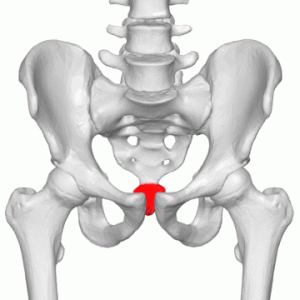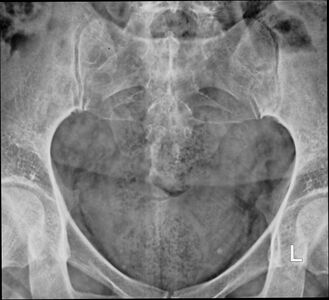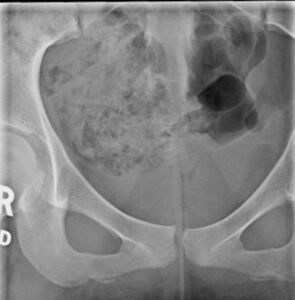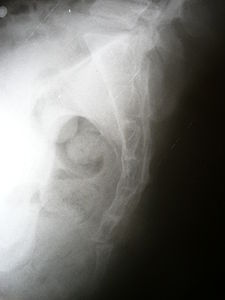Coccyx fracture
| Coccyx fracture | |
|---|---|
 | |
| Coccyx (tail bone) | |
| Specialty | Orthopedics |
| Symptoms | 'Tail bone' pain[1] |
| Risk factors | Fall onto bottom[1] |
| Diagnostic method | By examination,[1] X-ray not usually required[2] |
| Treatment | Rest, pain relief[1] |
| Medication | non steroidal anti-inflammatory drug[1] |
A coccyx fracture is a break in the coccyx, and typically presents with 'tail bone' pain after a fall backwards onto the bottom.[1] The pain tends to worsen on sitting for long periods of time or when getting up from sitting.[1]
Diagnosis is by examination and rectal examination, with the tail bone being found to be tender to touch.[2] An X-ray does not always show the break and is not usually required.[2] Treatment is with rest and pain relief such as non steroidal anti-inflammatory drug, which can be bought over the counter.[1] Sitting on a wedge-shaped cushion can help take pressure off the tail bone and most people get better without treatment.[1] If the pain is prolonged, an injection into the area may be an option.[2]
Causes
Causes of coccyx fracture can vary greatly, but are most commonly confined to falls into the seated position, or childbirth.
Risk factors
The following risk factors have been identified for coccyx fracture:
- Lack of/reduced muscle mass
- Advanced age
- Osteoporosis
- Being of the female sex (due to the wider pelvis typically found in females)
- Violence
Symptoms of coccyx fracture include:
- Pain that increases in severity when sitting or getting up from a chair, or when experiencing bowel movement
- Provoked pain over the tailbone
- Nausea
- Bruising or swelling in the tailbone area
Diagnosis
The standard workup of a suspected coccyx fracture includes medical history and a physical examination including a rectal examination.[2] An X-ray is generally not required.[2][3]
-
X-ray
-
X-ray
-
Lateral radiograph showing a fracture of the coccyx, as well as a lower lumbar fracture
-
MRI
Treatment
If the coccyx fracture is severe enough, short-term hospitalisation may be required, although this is extremely rare. More often, self-care at home is administered.
Sitting on soft surfaces is recommended, as this reduces pressure on the coccyx. A 'donut' or 'wedge' cushion may be purchased – these are simply cushions with a hole in them to ensure that no weight is placed in the injured tailbone. Painkillers such as ibuprofen are also recommended, as is a diet high in fibre to soften stools and avoid constipation.
Doctors will not usually attempt to correct a bad alignment, as muscles in the area are powerful and can pull the bone back into the 'bad' position. The bone is also very difficult to immobilise simply due to the sheer number of muscles attached to it, as well as the position.
Surgery
Following a coccyx fracture, surgery is not usually required. However, if the pain continues even after the fracture has healed, and is severe enough to cause serious disability, surgical removal of the coccyx (coccygectomy) may be required.[medical citation needed]
See also
- Sacral fracture (rarer)
References
- ↑ 1.0 1.1 1.2 1.3 1.4 1.5 1.6 1.7 1.8 Hecht, Andrew; Markowitz, Jonathon S. (2022). "13. Spine dislocations and fractures". In Mostoufi, S. Ali; George, Tony K.; Jr, Alfred J. Tria (eds.). Clinical Guide to Musculoskeletal Medicine: A Multidisciplinary Approach. Springer. pp. 112–115. ISBN 978-3-030-92041-8. Archived from the original on 2022-09-27. Retrieved 2022-09-21.
- ↑ 2.0 2.1 2.2 2.3 2.4 2.5 White, Timothy O.; Mackenzie, Samuel P.; Gray, Alasdair J. (2016). "14. Spine". McRae's Orthopaedic Trauma and Emergency Fracture Management (3rd ed.). Elsevier. p. 318. ISBN 978-0-7020-5728-1. Archived from the original on 2021-08-28. Retrieved 2022-09-21.
- ↑ Hanna, Tarek N.; Sadiq, Mahniya; Ditkofsky, Noah; Benayoun, Marc; Datir, Abhijit; Rohatgi, Saurabh; Khosa, Faisal (2016). "Sacrum and Coccyx Radiographs Have Limited Clinical Impact in the Emergency Department". American Journal of Roentgenology. 206 (4): 681–686. doi:10.2214/AJR.15.15095. ISSN 0361-803X. PMID 26867062.



